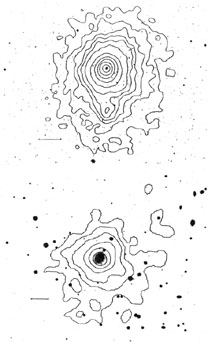Copyright © 1982 by Annual Reviews. All rights reserved
| Annu. Rev. Astron. Astrophys. 1982. 20:
547-85 Copyright © 1982 by Annual Reviews. All rights reserved |
4.4 Spiral-Poor Clusters with cD Galaxies
High-luminosity X-ray clusters (> 1044 erg s-1)
are often associated
with clusters containing dominant galaxies
(Bahcall 1977c,
McHardy 1978).
The X-ray temperatures of these clusters are hot
( 6 keV;
Mushotzky & Smith
1980)
implying that the gas is bound by the
potential of the cluster and is not associated with individual galaxies.
6 keV;
Mushotzky & Smith
1980)
implying that the gas is bound by the
potential of the cluster and is not associated with individual galaxies.
Abell 85 is a typical example of a dynamically evolved cD cluster. The cluster luminosity is 4 x 1044 erg s-1 (0.5-3 keV) within 0.5 Mpc. Its spectrum is characterized by a temperature of 6.8 ± 0.5 keV with iron-line emission (Mushotzky & Smith 1980). Figure 9 shows the Einstein low- and high- resolution images. As in other evolved cD clusters, the X-ray emission is smooth and symmetric around the dominant galaxy, implying a relaxed system. The only departure from radial symmetry is the low surface brightness extension to the south seen in the IPC observation.

|
Figure 9. X-ray isointensity contours of the smoothed 0.5-3.0 keV IPC image of Abell 85 (upper) and the contours derived from an HRI image (lower) are superposed on an optical photograph. The bar in the IPC image is 5' long, while that in the HRI is 1'. The contour levels for the IPC and HRI images are 3, 7, 11, 15, 19, 31, 43, 59, 75, 95, and 105 sigma and 3, 5, 7, 11, 15, 19, and 23 sigma respectively. The X-ray emission is centered on the giant cD galaxy and the steep gradient in the levels indicates the peaked nature of the emission. |
Figure 10 shows the radial surface brightness
profile obtained from
the X-ray images. For the isothermal-hydrostatic model
(Section 2.2)
and the measured luminosity and temperature, the central gas density
is about 10-2 cm-3. This exceeds the density
required for thermal
bremsstrahlung cooling in less than a Hubble time. For clusters with
central cooling regions, accretion flows deposit the cooling gas on
the central, stationary (or slowly moving) galaxy at the bottom of the
cluster potential well
(Fabian & Nulsen
1977).
The Abell 85 emission
observed above the profile in the central ~ 50 kpc region corresponds
to a luminosity of ~ 2 x 1043 erg s-1, which is
about 5% of the cluster
emission. This excess emission may be caused by pressure-driven,
cooling accretion flows as observed around NGC 1275 in Perseus (see
Section 4.5). Additional support for this
model is provided by
Heckman's (1981)
discovery in the ASS eD galaxy of a spatially resolved
emission-line region with a size of ~ 45 kpc and an
H [NII] luminosity
about 30% of that found for the ~90 kpc emission-line region in
NGC 1275. From Einstein SSS observations, Mushotzky
& Holii (private
communication) have placed an upper limit of approximately 8% on the
ratio of the emission integral of cool gas to the total of
Abell 85. Although the X-ray spectroscopic
observations were not
sufficiently sensitive to detect cool gas in the Abell 85 core, the
X-ray surface brightness profile coupled with the observation of an
extended optical emission-line region provide strong evidence that
cooling is occurring in the cluster center.
[NII] luminosity
about 30% of that found for the ~90 kpc emission-line region in
NGC 1275. From Einstein SSS observations, Mushotzky
& Holii (private
communication) have placed an upper limit of approximately 8% on the
ratio of the emission integral of cool gas to the total of
Abell 85. Although the X-ray spectroscopic
observations were not
sufficiently sensitive to detect cool gas in the Abell 85 core, the
X-ray surface brightness profile coupled with the observation of an
extended optical emission-line region provide strong evidence that
cooling is occurring in the cluster center.

|
Figure 10. The combined 0.5-3.0 keV IPC
(solid lines) and HRI (dashed
histogram) surface brightness profile of Abell 85. At small radii, the
IPC profile turns over and departs from the HRI due to the IPC's lower
resolution. The curve a = 250 kpc,
|
For the cD cluster Abell 1795, which has a similar X-ray luminosity,
temperature, and surface brightness profile to those of Abell 85,
Mushotzky & Holt did detect cool gas from the central region, with an
emission integral several percent that of the hot gas. Also in the
Abell 1795 cD galaxy, Heckman found an optical
emission-line region
with a size of ~ 25 kpc and an
H [NII] luminosity comparable to that
found in the Abell 85 cD.
[NII] luminosity comparable to that
found in the Abell 85 cD.